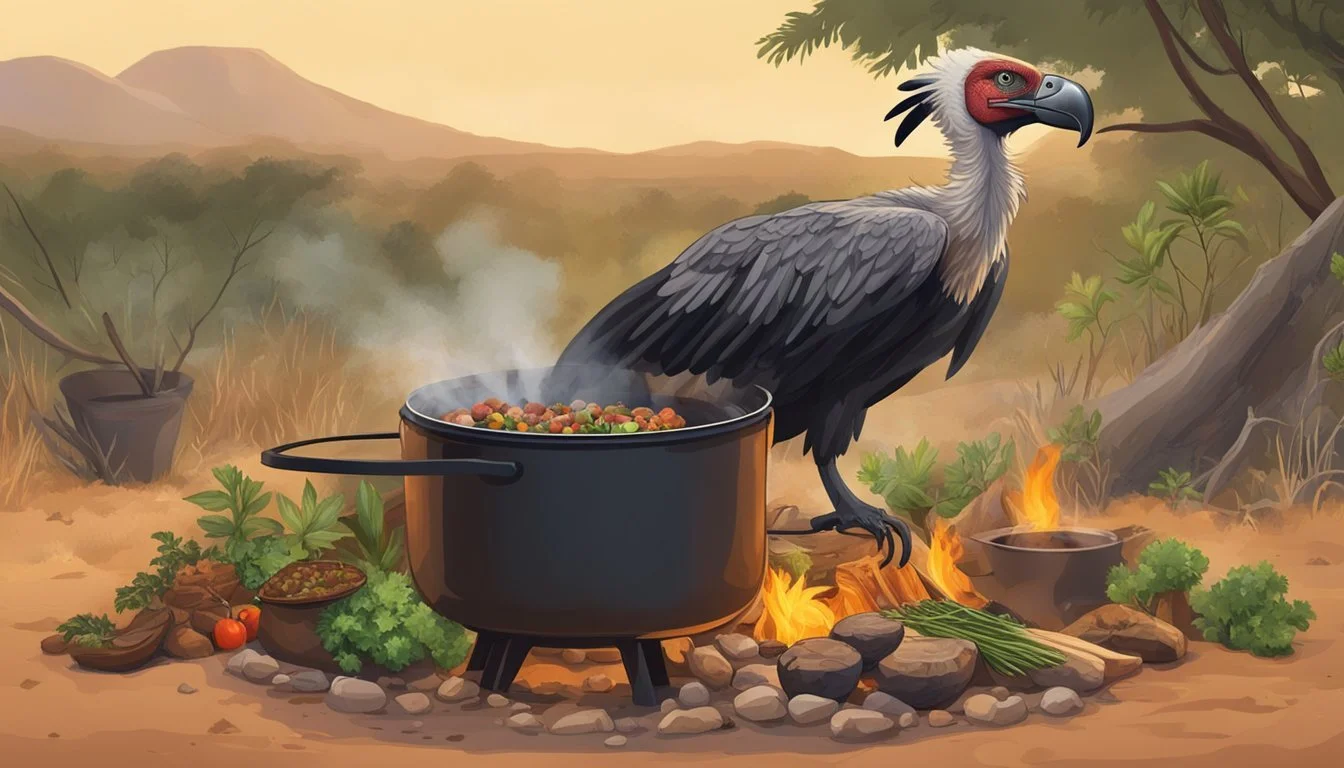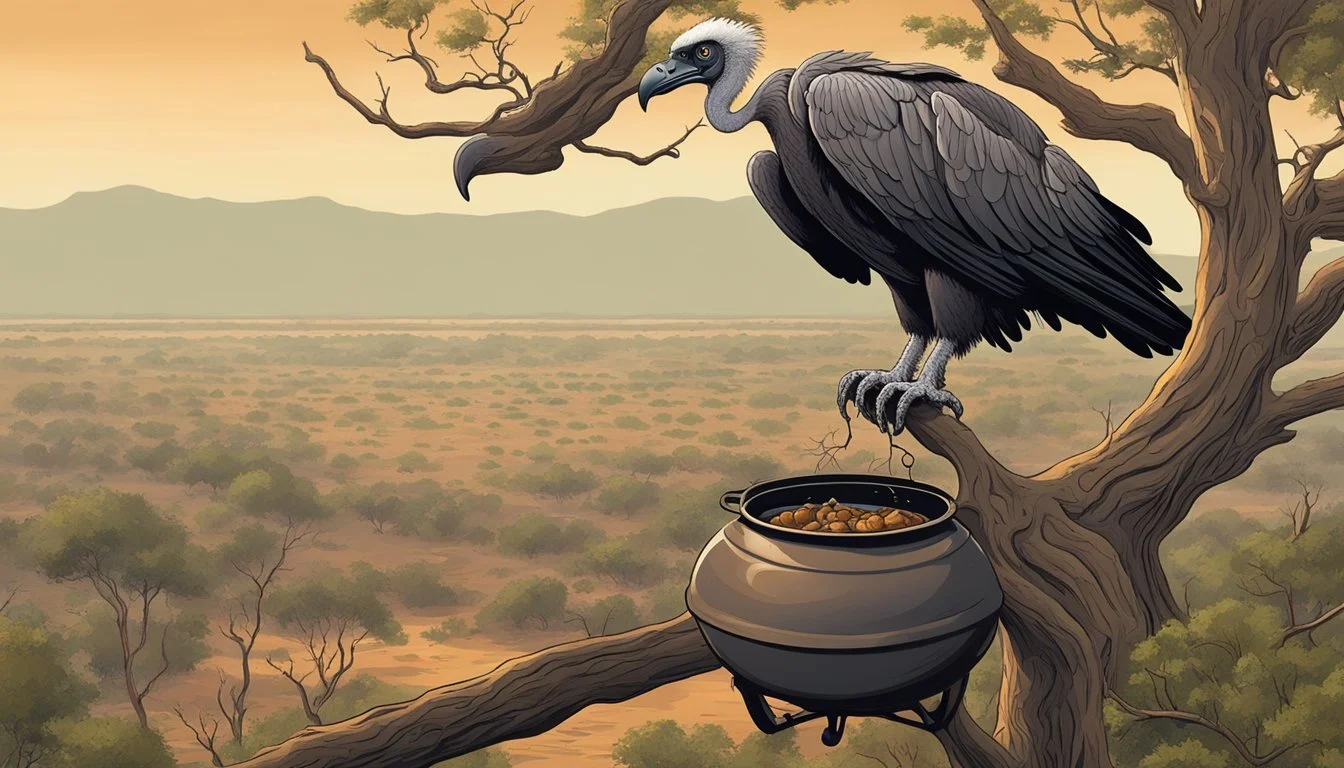Vulture Stew
Unveiling the African Bush Survival Cuisine
Vulture stew is a dish that arises from the depths of survival cuisine in the African bush, a testament to the resourcefulness and adaptability of its people. It's a dish not commonly found on the tourist trail or in urban restaurants, as it is primarily associated with survival tactics in remote areas. Vultures, often seen circling the African skies, are not typically considered a food source due to cultural taboos and the bird's diet of carrion. However, in extreme survival scenarios, no potential source of nutrition can be overlooked. This stew is indicative of the lengths to which individuals will go to sustain themselves.
As a cuisine, vulture stew is as much about culture and tradition as it is about sustenance. It reflects an intimate understanding of the environment and showcases the innate human ability to adapt to challenging conditions. Preparing and consuming vulture may not be widespread, but the practice speaks to a larger narrative of African bush cuisine, where dishes are born from necessity and are honed over generations into flavorful fare. The stew is often a simple affair, with the vulture meat stewed to tenderness with whatever local ingredients are available, and it is seasoned according to regional tastes.
The significance of dishes like vulture stew extends beyond their immediate nutritional value; they carry with them the stories and survival strategies of a people intimately connected with their land. While it might not grace tables on a daily basis, the rare preparation of vulture stew encapsulates a spirit of survival and resilience that is emblematic of the harsh yet resource-abundant landscapes of the African bush.
Historical Context and Significance
Vulture stew, a lesser-known African bush dish, has its roots steeped in the pragmatism necessary for survival and bears the weight of tradition and history within its preparation and consumption.
Origins of Vulture Stew
In the harsh and unpredictable environments of West Africa, vulture stew emerged as a survival food. Its creation is believed to be born out of necessity, where the scavenging bird often became a resource in times of scarcity. The practice of utilising vultures, despite some cultural taboos, illustrates the adaptability of the human diet under extreme conditions.
Cultural Importance in Bush Survival
For certain communities, especially within remote areas where resources can be limited, vulture stew represents more than sustenance; it embodies resilience and the ingenuity to use what the land provides. West African narratives often highlight the creativity involved in bush cooking, with vulture stew serving as evidence of how people can survive off the land, regardless of circumstances.
Evolution of the Dish
As with many traditional dishes, vulture stew has undergone an evolution over time. What might have started out of urgency, has woven its way into the fabric of local tradition and history. Although not widespread, the stew's existence is a testament to the diversified dietary practices across Africa and the measures communities have taken to endure and adapt to their environment.
Ingredients and Preparation
Creating Vulture Stew, a traditional African bush dish, involves a blend of indigenous flavors and resourceful cooking techniques tailored for survival conditions. The preparation method and ingredients — ranging from vulture meat to an array of vegetables and spices — reflect a deep connection to the land and the culinary creativity that arises from making do with available resources.
Common Base Ingredients
The foundation of any bush stew starts with water, a staple, which is crucial for the stew's consistency. Alongside it, salt is a key seasoning that highlights the flavors of the other ingredients. Palm oil is commonly used for its rich taste and calorie-dense properties, providing an energy boost critical for survival.
Meat Selection: From Vulture to Alternative Proteins
Traditionally, vulture meat is the protein of choice, primarily due to its availability as a resource in certain African regions. However, alternatives such as chicken or fish are also employed, catering to availability and preference. When preparing the meat, one must ensure it is thoroughly cleaned and cooked to ensure safety.
Vegetables and Spices
Vegetables are pivotal, with tomatoes and onions serving as the aromatic base. They're complemented by spices such as ginger and garlic to enhance the flavor profile. Pepper — often scotch bonnet or habanero — is included for heat, but must be used judiciously to cater to varying palates.
Cooking Methods
The stew is typically prepared over an open fire or charcoal. It begins with heating palm oil, to which onions and tomato paste are then added, followed by the ground spices. Once the base achieves a rich aroma, water is introduced, alongside the meat and vegetables, to simmer until all ingredients are tender. Cooke time can vary based on the meat and vegetable sizes.
Variations and Regional Twists
Vulture Stew, a traditional African bush dish, has evolved through various regional influences that have contributed unique twists to the recipe. Each region incorporates local ingredients and cultural preferences, leading to a rich tapestry of flavors and styles across the continent.
West African Influence
West Africa is known for its robust flavors and often spicy foods, with countries like Nigeria and Senegal having a significant impact on the regional cuisine. In West African variations of Vulture Stew:
Nigeria may incorporate elements from its popular Jollof, infusing the stew with a distinct tomato base and aromatic spices.
Senegal, known for its versatile use of grains and legumes, might add native grains like millet or fonio, enriching the stew's texture.
Adaptations in Southern and Eastern Africa
Moving to Southern and Eastern Africa, adaptations emphasize a different set of flavors and ingredients.
In places like South Africa, the stew might be less spicy but more sweet and savory, including ingredients like apricots or tamarind.
The Eastern African influence often includes the use of coconut milk for a creamy consistency and added herbs for a fragrant bouquet.
Nutritional Information
In this section, we examine the nutritional content of Vulture Stew, focusing on the macronutrients and micronutrients it contains and the health benefits associated with a balanced diet that includes dishes like this one.
Macronutrients and Micronutrients
Protein: Vulture meat is a source of protein, essential for muscle repair and growth. Per serving, one can expect a significant amount of protein, which is vital for bodily functions.
Iron: This meat is also rich in iron, a critical component for blood production and oxygen transport.
Calcium: Although not as high as in other food sources, Vulture Stew provides some calcium, necessary for strong bones and teeth.
Fiber: Depending on the accompanying ingredients such as vegetables added to the stew, it can be a source of dietary fiber, which aids digestion.
The stew is fortified with a range of micronutrients that play various roles in maintaining the body's health, impacting everything from metabolic pathways to immune responses.
Health Benefits of a Balanced Diet
A balanced diet that includes protein-rich dishes (What wine goes well with rich dishes?) like Vulture Stew supports overall health. Iron from such protein sources is more easily absorbed by the body, combating anemia.
Fiber from the vegetables in the stew contributes to a healthy digestive system, reducing the risk of digestive disorders.
Complementing this stew with a variety of other dishes ensures an intake of essential nutrients, thereby promoting a robust and resilient body system.
Accompaniments
When preparing Vulture Stew, a customary African bush dish known for its survival benefits, it's important to consider which side dishes can complement its robust flavors. One can choose from traditional staples as well as modern sides that resonate with contemporary palates.
Traditional Side Dishes
Rice: A common side, rice serves as a neutral base that allows the savory notes of the stew to shine through. It's often served as white rice or jollof rice, with the latter adding a spicy, tomato-infused flavor to the meal.
Fufu: This starchy, dough-like side made from boiled and pounded yam, cassava, or plantains, is perfect for soaking up the stew's sauce.
Yam: Regularly served boiled or fried, adding a comforting, earthy flavor.
Plantains: Either boiled or fried, they contribute a subtly sweet complement.
Beans and Greens: A combination that offers both protein and fiber. Beans are typically stewed, while the greens, often kale or similar leafy vegetables, are sautéed with garlic and sometimes mixed with okra to provide a hearty texture.
Modern Pairings
In modern cuisine, chefs might pair Vulture Stew with ingredients and dishes that aren't traditionally associated with African bush cooking but still provide a pleasing contrast or complementary flavor.
Roasted Butternut Squash: The natural sweetness offsets the potency of the stew.
Grilled Okra: (What wine goes well with grilled okra?) A contemporary take on the traditional okra, achieving a crispy texture.
Plantain Chips: For those preferring a crunch, thinly sliced and crisped plantains add texture and a mild sweetness.
Grains like quinoa or couscous: These can serve as novel replacements for rice or fufu, particularly appealing to those looking for gluten-free or higher-protein options.
Dietary Considerations
When considering the adaptation of vulture stew for dietary restrictions, it's essential to address the needs of vegetarians and vegans, as well as those following gluten-free or paleo diets. The following subsections offer alternatives to ensure the dish aligns with various dietary preferences.
Vegetarian and Vegan Alternatives
For vegetarians and vegans, substituting the traditional meat component of vulture stew is paramount. A high-protein plant-based alternative, such as chickpeas or lentils, can mimic the heartiness while providing essential nutrients. Mushrooms offer a meaty texture and can be an excellent base for the stew. Adding a variety of vegetables like sweet potatoes and carrots can enhance the flavor profile and nutritional value.
Protein Alternatives
Chickpeas
Lentils
Tempeh
Texture Alternatives
Portobello mushrooms
Eggplant
Gluten-Free and Paleo Options
Gluten-free and paleo diets exclude grains and processed foods. To make vulture stew compatible with these diets, thickeners such as wheat flour should be avoided. Instead, one can use arrowroot or tapioca starch as gluten-free thickeners. For paleo followers, the stew must omit legumes, so focusing on meat and vegetables is key. Using high-quality, pasture-raised meat sources and a variety of root vegetables will maintain the dish's integrity and keep it within paleo guidelines.
Gluten-Free Thickeners
Arrowroot powder
Tapioca starch
Paleo-friendly Ingredients
Pasture-raised meats (substituted for vulture meat)
Root vegetables (e.g., turnips, parsnips)
Home Cooking vs. Restaurant Experience
When it comes to Vulture Stew, the cooking environment—be it the home or a restaurant—can greatly influence the preparation and flavor of this traditional African dish. Here are some specifics about crafting Vulture Stew in both settings.
Preparing Vulture Stew at Home
In the home kitchen, one follows the recipe with a personal touch, adjusting the spices and ingredients to suit their family's tastes. Home cooks often rely on traditional methods passed down through generations, which might not be strictly adhered to in a restaurant setting. The intimate experience of preparing Vulture Stew at home allows for improvisation, with each family potentially having their unique version of the dish. However, sourcing ingredients such as vulture meat, which is a rarity and may have legal and ethical considerations, can make home preparation challenging.
Where to Find Authentic Vulture Stew
For those seeking the flavors of authentic Vulture Stew without cooking it themselves, dining out becomes an option. Restaurants specializing in African cuisine may offer this dish, allowing diners to experience the robust flavors crafted by professional chefs. Restaurants equip their kitchens with commercial-grade appliances that can more consistently produce large quantities of the stew. However, authenticity in taste may vary from one establishment to another, with chefs potentially adapting the recipe for broader appeal or due to ingredient availability. The table below compares key aspects of home cooking and dining out:
Aspect: Ingredients
Home Cooking: Personal sourcing, potentially more authentic.
Restaurant Experience: May substitute for availability or appeal.
Aspect: Cooking Method
Home Cooking: Traditional, slow-cooked.
Restaurant Experience: May be adapted for efficiency.
Aspect: Flavor
Home Cooking: Personalized to taste.
Restaurant Experience: Standardized for consistency.
Aspect: Ambience
Home Cooking: Family setting, intimate.
Restaurant Experience: Professional setting, wider social experience.
One's preferences for either home cooking or the restaurant experience will shape where and how they choose to enjoy Vulture Stew.
Role in Modern Cuisine and Popularity
Vulture stew, traditionally viewed as a survival food in African bush culture, has seen its profile rise in modern culinary circles. Its unique history and flavor profile contribute to its emerging popularity and incorporation into fusion dishes.
Global Influence and Fusion Cuisines
The growing interest in traditional and authentic dishes has led chefs around the world to experiment with African bush cuisine. Vulture stew, with its deep African roots, has become a canvas for fusion, combining its hearty and earthy flavors (What wine goes well with earthy flavors?) with elements from other global cuisines. These include French, Asian, or Latin American techniques and ingredients, underscoring the stew's versatility and adaptability in the global culinary landscape.
Social Media and the Rise of Food Trends
On platforms like Instagram, vulture stew has benefited from the visual appeal of exotic cuisines and the trend towards culinary exploration. Food bloggers and influencers often seek out unique dishes to share with their audiences, and the distinctiveness of vulture stew captures attention. This visibility has not only introduced the dish to a broader audience but has also played a role in its modern resurgence as a niche food trend.
Sustainable Practices and Waste Reduction
The cornerstone of sustainable practices in African bush cuisine, particularly when it comes to preparing Vulture Stew, revolves around the efficient use of available resources and the reduction of waste. This section examines the methods by which leftovers are recycled into meals and the ethical implications of meat consumption in the context of survival food.
Using Leftovers and Reducing Food Waste
Culinary practices in the preparation of Vulture Stew emphasize the maximization of resources. Cooks utilize every edible part of ingredients, ensuring that nothing goes to waste. Leftover bones, for example, are often boiled to make nutritious broths, while meat scraps are incorporated into later meals. Such actions not only reduce waste but also underline a commitment to sustainable cooking methods.
Key strategies for waste reduction include:
Preserving meat through traditional methods such as smoking or drying.
Utilizing vegetable peelings and offcuts to enrich stews (What wine goes well with stews?) or create compost.
Implementing portion control to prevent cooking excess food.
Ethical Considerations of Meat Consumption
The ethics of meat consumption in the making of Vulture Stew involves a critical evaluation of the environmental impact and the sustainability of using wildlife for food. Traditional preparation methods, which are often passed down through generations, may include using meat from scavengers like vultures. However, increased awareness has led communities to consider the ecological roles of these birds and the repercussions of their use as a food source.
Ethical concerns to be addressed entail:
The endangered status of many vulture species and the need for their conservation.
Balancing cultural practices with modern wildlife management and protection strategies.
Exploring alternative protein sources that do not jeopardize biodiversity.
Conclusion
Vulture stew represents more than a mere survival food throughout various regions in Africa; it is an embodiment of adaptability in African cuisine. This dish, often necessitated by challenging conditions, is traditionally prepared from the meat of vultures, a bird species facing threats of extinction due to various factors, including poisoning and habitat disruption.
In the context of African gastronomy, vulture stew is a testament to the resourcefulness within the continent's culinary practices. It highlights a deep-seated ability to create nourishing meals amidst scarcity. At its core, African cuisine is diverse and robust, extending beyond a single dish to encompass a wide range of flavors and ingredients, thus reflecting the continent's rich cultural tapestry.
The precarious state of the vulture population adds a layer of urgency and complexity to the consumption of this dish. The cultural significance of vulture stew underscores the intersection between a community's survival strategies and the broader environmental impact of such practices.
In embarking on a culinary journey through Africa, one should be conscious of the delicacy's role in the food ecosystem and its implications for wildlife conservation efforts. The future of dishes like vulture stew is intertwined with sustainable practices and the preservation of Africa's majestic wildlife.
The dialogue surrounding African gastronomy, particularly dishes crafted for sustenance, continues to evolve. It demands an understanding that respects both the culinary heritage and the ecological balance necessary for the continuation of these traditions.











